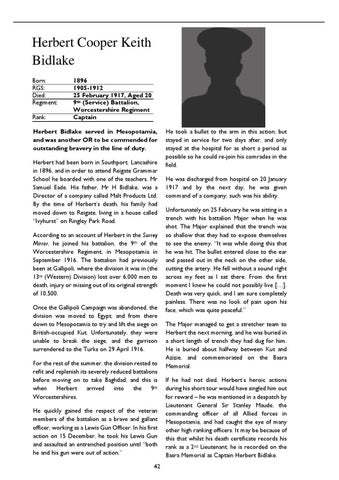Herbert Cooper Keith Bidlake Born: RGS: Died: Regiment: Rank:
1896 1905-1912 25 February 1917, Aged 20 9th (Service) Battalion, Worcestershire Regiment Captain
Herbert Bidlake served in Mesopotamia, and was another OR to be commended for outstanding bravery in the line of duty. Herbert had been born in Southport, Lancashire in 1896, and in order to attend Reigate Grammar School he boarded with one of the teachers, Mr Samuel Eade. His father, Mr H Bidlake, was a Director of a company called Malt Products Ltd. By the time of Herbert’s death, his family had moved down to Reigate, living in a house called “Ivyhurst” on Ringley Park Road. According to an account of Herbert in the Surrey Mirror, he joined his battalion, the 9th of the Worcestershire Regiment, in Mesopotamia in September 1916. The battalion had previously been at Gallipoli, where the division it was in (the 13th (Western) Division) lost over 6,000 men to death, injury or missing out of its original strength of 10,500. Once the Gallipoli Campaign was abandoned, the division was moved to Egypt, and from there down to Mesopotamia to try and lift the siege on British-occupied Kut. Unfortunately, they were unable to break the siege, and the garrison surrendered to the Turks on 29 April 1916. For the rest of the summer, the division rested to refit and replenish its severely reduced battalions before moving on to take Baghdad, and this is when Herbert arrived into the 9th Worcestershires. He quickly gained the respect of the veteran members of the battalion as a brave and gallant officer, working as a Lewis Gun Officer. In his first action on 15 December, he took his Lewis Gun and assaulted an entrenched position until “both he and his gun were out of action.” 42
He took a bullet to the arm in this action, but stayed in service for two days after, and only stayed at the hospital for as short a period as possible so he could re-join his comrades in the field. He was discharged from hospital on 20 January 1917 and by the next day, he was given command of a company; such was his ability. Unfortunately on 25 February he was sitting in a trench with his battalion Major when he was shot. The Major explained that the trench was so shallow that they had to expose themselves to see the enemy. “It was while doing this that he was hit. The bullet entered close to the ear and passed out in the neck on the other side, cutting the artery. He fell without a sound right across my feet as I sat there. From the first moment I knew he could not possibly live […]. Death was very quick, and I am sure completely painless. There was no look of pain upon his face, which was quite peaceful.” The Major managed to get a stretcher team to Herbert the next morning, and he was buried in a short length of trench they had dug for him. He is buried about halfway between Kut and Azizie, and commemorated on the Basra Memorial. If he had not died, Herbert’s heroic actions during his short tour would have singled him out for reward – he was mentioned in a despatch by Lieutenant General Sir Stanley Maude, the commanding officer of all Allied forces in Mesopotamia, and had caught the eye of many other high ranking officers. It may be because of this that whilst his death certificate records his rank as a 2nd Lieutenant, he is recorded on the Basra Memorial as Captain Herbert Bidlake.
